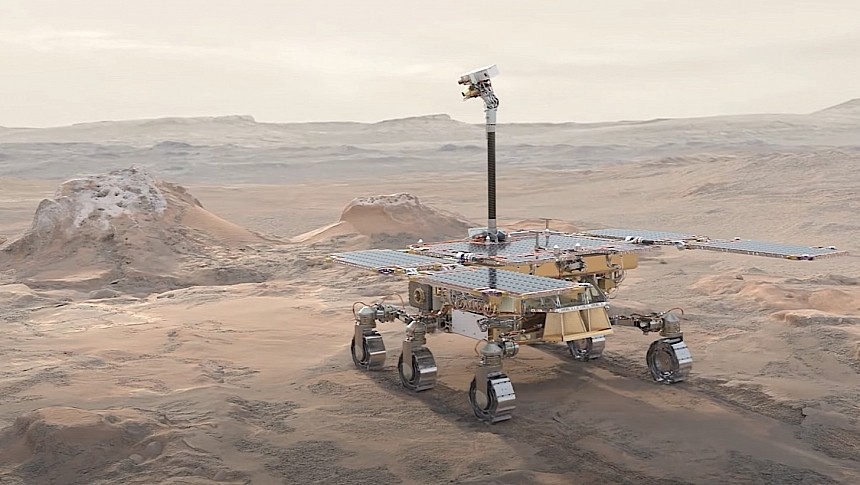After the arrival of the Perseverance rover on Mars back in 2021, the fleet of human-made rovers on location on the neighboring planet has grown to six. Despite each of them having their own specific mission, all have to some degree looked for signs of past or present life there. None was found.
Because Perseverance is so young and NASA is all tied up in the Artemis Moon exploration program, it's unlikely the Americans will be sending a new such machine up there anytime soon. The Europeans, however, will, and they call this Mars mission of theirs the most ambitious yet.
The stated goal of the European Space Agency (ESA) ExoMars mission is to search for signs of life. This will be done by means of a rover called Rosalind Franklin, in honor of the British chemist who significantly advanced humanity's knowledge of the inner workings of DNA.
The rover should have already been on the job on Mars, as it was supposed to depart for the planet in 2020, onboard a Russian Roscosmos rocket. That initial launch was pushed to 2022 on account of some technical issues with the rover's parachutes.
The 2022 launch deadline was not met either, this time because Russia decided to invade Ukraine, got slapped with tons of sanctions, and retaliated by pulling its support from the few remaining international programs it was still involved in. Including launching Western gear with Soyuz rockets.
As it stands, the mission is now scheduled to depart in 2028, and it will put on the surface of the alien world the continent's first ever rover.
Made in part by Airbus, the Rosalind Franklin is packed full of instruments that should allow it to detect signs of life, but the most impressive piece of gear is the drill with which it will dig deep for signs of little green men.
How deep? Simply put, the deepest any human-made robot has ever been able to dig on Mars, a staggering two meters (6.6 feet) below the surface. It's there, scientists believe, where the biggest chance of finding signs of life resides, because it's deep enough for the planet's crust to protect samples from radiation and extreme temperatures.
Although there is a lot of time left until the mission departs, ESA thought it would be best to give us a taste of the mission in a so-called trailer. And not just any trailer, but one that shows in minute detail the rover itself (down the color, elements, and even scratches on its body), but also the breathtaking Martian landscape. And we even see that impressive drill in action.
The clip, which you can enjoy below, is part of "the most accurate animation series made so far of a Mars mission," a series which we are already itching to see in full (it's unclear when the series will be released).
The stated goal of the European Space Agency (ESA) ExoMars mission is to search for signs of life. This will be done by means of a rover called Rosalind Franklin, in honor of the British chemist who significantly advanced humanity's knowledge of the inner workings of DNA.
The rover should have already been on the job on Mars, as it was supposed to depart for the planet in 2020, onboard a Russian Roscosmos rocket. That initial launch was pushed to 2022 on account of some technical issues with the rover's parachutes.
The 2022 launch deadline was not met either, this time because Russia decided to invade Ukraine, got slapped with tons of sanctions, and retaliated by pulling its support from the few remaining international programs it was still involved in. Including launching Western gear with Soyuz rockets.
As it stands, the mission is now scheduled to depart in 2028, and it will put on the surface of the alien world the continent's first ever rover.
Made in part by Airbus, the Rosalind Franklin is packed full of instruments that should allow it to detect signs of life, but the most impressive piece of gear is the drill with which it will dig deep for signs of little green men.
How deep? Simply put, the deepest any human-made robot has ever been able to dig on Mars, a staggering two meters (6.6 feet) below the surface. It's there, scientists believe, where the biggest chance of finding signs of life resides, because it's deep enough for the planet's crust to protect samples from radiation and extreme temperatures.
Although there is a lot of time left until the mission departs, ESA thought it would be best to give us a taste of the mission in a so-called trailer. And not just any trailer, but one that shows in minute detail the rover itself (down the color, elements, and even scratches on its body), but also the breathtaking Martian landscape. And we even see that impressive drill in action.
The clip, which you can enjoy below, is part of "the most accurate animation series made so far of a Mars mission," a series which we are already itching to see in full (it's unclear when the series will be released).








